
Hello, literature enthusiasts! Welcome to our journey into the rich tapestry of classic Spanish literature. Spanish literature, with its deep roots and expansive branches, offers a lush garden of stories, poetry, and plays that have captivated readers and influenced writers around the world for centuries.
Classic Spanish refers to the Spanish-speaking world’s foundational and historically significant literature. These works have made a lasting impact on Spanish literature, culture, and even global literature. Many are studied in schools, referenced in other works, and have remained in print for centuries due to their enduring value and influence. Through Spanish classics, you can explore the rich history of Spanish and Latin American history and traditions.
Many Spanish classics, from the works of Cervantes to Gabriel García Márquez, have influenced global literature. Understanding these seminal works provides a deeper appreciation for literary references, styles, and innovations that have emanated from the Spanish-speaking world.
We’re diving into some of the most iconic and beloved classic Spanish books, each a masterpiece that has left an indelible mark on the literary landscape. Whether you’re a longtime admirer of Spanish literature or a curious newcomer eager to explore, you’re in for a treat. Let’s go on this literary adventure together and discover the timeless works that continue to inspire and enchant readers of all ages.
10 Classic Spanish Books
Like all classic literature, Spanish classics tackle universal themes: love, betrayal, ambition, societal structures, human nature, and more. Engaging with these topics leads to personal growth and a deeper understanding of human experience.
Especially for those outside the Spanish-speaking world, these classics introduce readers to new settings, customs, and worldviews, broadening one’s understanding and appreciation of global diversity. Here are ten classic Spanish books you should not miss. They offer a multifaceted experience, combining linguistic, cultural, historical, and personal enrichment. Let’s go!
| Name | Tropes | Average Rating (Goodreads) |
|---|---|---|
| Don Quixote by Miguel de Cervantes Saavedra | Chivalric Romance, Knight Errant, Satire, Metafiction, Misadventures, Quest, Damsel in Distress, Windmills as Giants, Comic Relief, Idealism vs. Realism. | 3.8/5 |
| One Hundred Years of Solitude by Gabriel García Márquez | Magic Realism, Generational Saga, Isolated Village, Incestuous Relationships, Political Allegory, Time Loop, Symbolism, Tragic Love, Family Curse, Circular Narrative. | 4.1/5 |
| The House of Bernarda Alba by Federico García Lorca | Family Drama, Repression, Social Class Conflict, Female Relationships, Tragic Ending, Power Struggles, Isolation, Foreshadowing, Symbolism, Secrets. | 4/5 |
| Blind Sunflowers by Alberto Méndez | Spanish Civil War, Historical Fiction, Family Secrets, Coming of Age, Friendship, Political Oppression, Moral Dilemmas, Loss of Innocence, Psychological Drama, Survival. | 3.9/5 |
| Ficciones by Jorge Luis Borges | Metafiction, Labyrinths, Paradoxes, Alternate Realities, Literary References, Philosophical Themes, Short Stories, Mirrors, Infinite Regress, Magical Realism. | 4.4/5 |
| The Aleph by Jorge Luis Borges | Metafiction, Infinite Realities, Cosmic Horror, Time Travel, Unreliable Narrator, Philosophical Themes, Short Stories, Mirrors, Infinite Knowledge, Paradoxes. | 4.3/5 |
| Hopscotch by Julio Cortázar | Nonlinear Narrative, Stream of Consciousness, Existentialism, Metafiction, Philosophical Themes, Experimental Structure, Multiple Endings, Literary Innovation, Parisian Setting, Intellectual Discourse. | 4.2/5 |
| In Search of Klingsor by Jorge Volpi | Historical Fiction, Espionage, Scientific Pursuit, Nazi Scientists, Cold War, Intellectual Thriller, International Settings, Quest for Knowledge, Moral Dilemmas, Scientific Conspiracy. | 3.9/5 |
| The Shadow of the Wind by Carlos Ruiz Zafón | Mystery, Gothic Elements, Book Within a Book, Literary Allusions, Coming of Age, Forbidden Love, Historical Setting, Family Secrets, Intrigue, Metaphysical Themes. | 4.2/5 |
| The Celestina by Fernando de Rojas | Tragicomedy, Love Triangle, Bawdy Humor, Social Satire, Moral Ambiguity, Intrigue, Complex Characters, Spanish Literature, Human Foibles, Foreshadowing. | 3.3/5 |
1. Don Quixote by Miguel de Cervantes Saavedra (1605)
Don Quixote is one of Western literature’s most important and influential works. First published in two parts in 1605 and 1615, the novel is considered the first modern European novel. It has been translated into more languages than any other book, except for the Bible, and continues to be widely read and studied today.
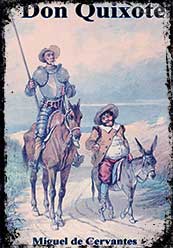
Synopsis: The story revolves around the character of Don Quixote, an aging gentleman from La Mancha in Spain, who becomes enamored with chivalric romances. He becomes so obsessed that he decides to become a knight-errant himself, despite the chivalric age having long passed.
Accompanied by his loyal squire, Sancho Panza, Don Quixote goes on a series of adventures, battling windmills he mistakes for giants and championing the cause of the helpless and the oppressed. His romantic vision clashes with the harsh realities he meets, creating a rich tapestry of comedy and tragedy.
Themes: The core theme is the tension between illusion and reality. Don Quixote, blinded by his reading of chivalric romances, sees the world not as it is but as he believes it should be. This theme is explored from multiple angles, including the narratives we create to make sense of our world.
The novel raises questions about the nature of sanity. While Don Quixote is considered mad, his madness reveals the absurdities and injustices of the world around him. Don Quixote’s delusional yet sincere acts of valor pose deep questions about what it means to be a hero. His actions are foolish but also courageous and well-intentioned.
Analysis: Cervantes satirizes the popular chivalric romances of his time, critiquing their unrealistic portrayal of heroism and love. He argues for a more detailed understanding of literature’s role in shaping and being shaped by reality. Through the lens of humor and satire, the book offers scathing commentary on various aspects of society, from governance and law to religion and human nature.
The language is ornate but also easy, with rich dialogues and descriptions. The dynamic between Don Quixote and Sancho Panza offers much of the story’s humor, as the lofty, archaic language of the deluded knight contrasts sharply with the earthy, pragmatic words of his squire. It is a great novel and a foundational text of Western literature. Reading it offers a deep understanding of Spanish culture and history and a profound exploration of humanity’s eternal struggles.
2. One Hundred Years of Solitude by Gabriel García Márquez (1967)
One Hundred Years of Solitude (“Cien años de soledad”), published in 1967, is a landmark work in modern literature and one of the most celebrated examples of the genre known as magical realism. This book catapulted García Márquez to international fame and is widely considered one of the most important works in world literature.
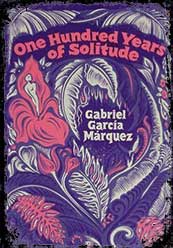
Synopsis: Set in the mythical Colombian town of Macondo, the novel follows the lives of seven generations of the Buendía family. Beginning with the patriarch José Arcadio Buendía and ending with his descendent Aureliano, who deciphers the family’s long and intricate history just as Macondo is wiped off the map. The novel explores the intertwined fates of the Buendía family and their town, blending historical, political, and personal dramas.
Themes: Each character in the Buendía family experiences some form of solitude or alienation, whether it’s a result of their obsessive pursuits, unrequited loves, or moral quandaries. This theme is a recurring motif and serves as a metaphor for Colombia’s isolated development.
Blending the fantastical with the mundane is a cornerstone of the novel, amplifying the characters’ emotional truths. The boundaries between myth and reality blur, making the unbelievable appear ordinary and the ordinary appear unbelievable. The characters and events in the book mirror or repeat those of previous generations, suggesting that history is cyclical. The novel’s timeline is not linear, and the past, present, and future often merge into a single moment.
Analysis: The history of Macondo is entwined with political upheavals, wars, and revolutions, which can be read as a microcosm of Latin American history. From the era of colonization to the banana boom and its subsequent massacre, the novel explores the complexities of regional politics and exploitation. The book comments on its storytelling, narrative scope, and the inevitable decay of memory and history.
The prose is lush and poetic, filled with intricate details and sensory descriptions that lend a dream-like quality to the narrative. The sprawling, multi-generational structure of the novel allows for a rich tapestry of characters and events, tied together by recurring motifs and parallel situations.
It won numerous awards and cemented García Márquez’s reputation as a Nobel laureate. It has been translated into multiple languages and continues to be studied and revered today. Its influence can be felt in literature, the arts, and political thought. A read that demands emotional and intellectual engagement remains a touchstone of modern literature.
3. The House of Bernarda Alba by Federico García Lorca (1936)
The House of Bernarda Alba (“La casa de Bernarda Alba”) is an old Spanish play written in 1936 by the Spanish playwright Federico García Lorca, shortly before his execution during the Spanish Civil War. It is considered one of his masterpieces and a classic of modern drama. The play was not performed until 1945, nearly a decade after Lorca’s death.
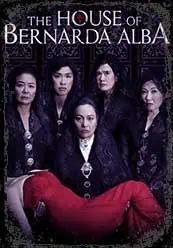
Synopsis: The play is set in a small Andalusian village in Spain and focuses on the life of Bernarda Alba, a wealthy widow who imposes a period of mourning on her five unmarried daughters. The house becomes a cauldron of suppressed sexuality, jealousy, and stifled dreams as Bernarda seeks to control every aspect of her daughters’ lives, all in the name of family honor. The tension in the house culminates in tragedy, a dark outcome of the repressed emotions and societal norms that bind the characters.
Themes: Bernarda Alba is a tyrannical matriarch involving oppressive societal norms regarding gender and class. Her control over her daughters is a metaphor for the larger societal structures restricting women’s freedoms.
Analysis: The repressive environment in Bernarda’s house leads to a build-up of sexual tension among her daughters, further intensified by the presence of a desirable bachelor in the village. The play explores the consequences of bottling up natural desires due to societal norms.
The Alba family’s obsession with maintaining their social standing reveals the underlying class prejudices of the society in which they live. The characters are bound not only by the walls of their home but also by the invisible walls of social stratification.
Each daughter represents a different response to the conflict between desires and societal expectations. From Adela’s rebelliousness to Angustias’s conformity, the characters’ differing attitudes offer a comprehensive look at how people face the strictures imposed by their culture. The looming shadow of death hangs over the house. Bernarda’s mourning period for her late husband is a constant reminder of mortality, and death resolves the story’s tension grimly and tragically.
Style and Structure: The play employs a classical three-act structure but deviates from traditional narrative conventions by focusing on the inner lives of its female characters in a highly restricted setting. The house itself becomes a powerful symbol of confinement and repression. Lorca’s language is poetic and symbolic, employing local dialects and idioms to add authenticity to the dialogues.
Cultural and Historical Impact: This is a significant work in the feminist literary canon because of its acute portrayal of women’s lives in a patriarchal society. It’s also relevant for its commentary on Spain’s class and societal norms in the 1930s, a period leading to the Spanish Civil War, which subsequently claimed Lorca’s life. The play has been adapted into numerous languages and formats, including film and opera. It remains a popular work in both educational and professional theatre settings worldwide.
4. Blind Sunflowers by Alberto Méndez (2004)
Blind Sunflowers (“Los girasoles ciegos”) is a collection of four interlinked short stories. This classic YA Spanish book was Méndez’s debut and received critical acclaim, winning several awards, including the National Prize for Narrative in Spain. The stories are set during and after the Spanish Civil War, exploring the war’s moral, psychological, and emotional impact on individuals from different walks of life.
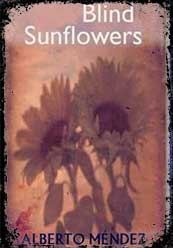
Synopsis: The four stories in the collection present varying perspectives on the Spanish Civil War and its aftermath. Characters range from disillusioned soldiers to struggling civilians, all grappling with the consequences of a devastating conflict that leaves no life untouched. One particularly poignant story focuses on a widow who must disguise her deceased husband’s anti-Franco sentiments to protect her son, all while teaching at a Francoist school.
Themes: Rather than dwelling on the political aspects of the grand narratives of the Spanish Civil War, “Blind Sunflowers” zeroes in on the experiences of ordinary individuals, showing the reader the immense human toll the war took. The characters are caught in morally complex situations where the lines between right and wrong are blurred. This reflects the moral ambiguities that many Spaniards had to face during a period of extreme ideological division.
Analysis: The emotional and psychological ramifications of the war are prominent throughout the book, affecting not only those who fought but also those who stayed behind. The mental strain can be seen in characters who betray their ideals to survive or protect their families. In the post-war period, silence became a means of survival for many characters. This imposed silence symbolizes the collective trauma and the suppressed memories Spain grappled with for decades after the war.
The war challenges the characters’ sense of self, forcing them to adhere to or deviate from their pre-war identities. For many, the loss is irrevocable, not only in terms of lives lost but also in terms of ideological and personal identity.
Style and Structure: Méndez adopts a simple yet evocative prose style, giving voice to his characters in an intimate and relatable manner. The book’s segmented structure allows for multiple perspectives on the war, making it a multi-faceted exploration of a complex historical event. It came when Spain became more open to revisiting the painful chapter of its Civil War and the Franco era. It contributed to a broader dialogue on the war’s lasting impact on the Spanish psyche and society.
5. Ficciones by Jorge Luis Borges (1944)
Ficciones is a collection of short stories widely considered one of the most significant works of 20th-century Spanish literature. It is a landmark in the genre of magical realism and metafiction. Borges combines philosophy, theology, and mythology to produce both intellectually challenging and highly imaginative stories.
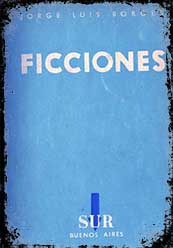
Synopsis: The book is divided into two main parts: “The Garden of Forking Paths” and “Artifices,” each containing a series of short stories exploring various themes and scenarios. Many stories involve paradoxes, labyrinths, mirrors, fictional writers, and various forms of infinite regress.
Some notable stories include “The Library of Babel,” which imagines a universe as a vast library containing all possible books, and “Pierre Menard, Author of the Quixote,” where a man tries to rewrite “Don Quixote” word for word in a different context, thereby making it a new work.
Themes: One of Borges’ key preoccupations is the relationship between reality and fiction. Many of his stories blur the line between the two, challenging readers to reconsider their perceptions of what is real.
Analysis: Concepts like infinity, eternity, and the boundless nature of human imagination are recurrent themes. Stories like “The Library of Babel” confront the human mind with conceptually endless scenarios, raising questions about the nature of the universe and our place in it.
Who are we? What makes us unique, or perhaps not unique at all? Borges plays with notions of identity, employing mirrors or twins as motifs that unsettle our understanding of individuality. The power and limitations of language are another focus in “Ficciones.” Borges frequently focuses on the inadequacy of words to capture the full extent of human experience and the universe’s complexities.
Many stories have a strong philosophical undertone, questioning the nature of time, existence, and the cosmos, alluding to classical and modern philosophical debates. Despite their complexity, the stories are also marked by a certain narrative economy, delivering profound insights in a relatively short span of words.
The book has been examined in academic settings across multiple disciplines, including philosophy, theology, and linguistics, for its rich thematic content. Whether you’re interested in philosophy, theology, or simply the art of storytelling, “Ficciones” is a must-read that opens up endless avenues for discussion and interpretation.
6. The Aleph by Jorge Luis Borges (1949)
The Aleph is another groundbreaking collection of short stories named after the story “The Aleph,” which is one of its most famous entries. The book carries many themes and stylistic elements introduced in Borges’ earlier work, “Ficciones.” The collection explores the interplay of reality and fiction, the limits of human understanding, and the metaphysical concerns that define much of Borges’ work.
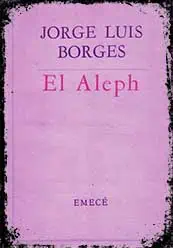
Synopsis: Like “Ficciones,” “The Aleph” is a compendium of short stories tackling various topics. The eponymous story, “The Aleph,” revolves around a point in space that contains all other points. Anyone who looks into it can see everything in the universe from every angle simultaneously, without distortion, overlap, or confusion. The stories in this collection range from the highly metaphysical to the historical and autobiographical, offering readers another fascinating glimpse into Borges’ rich intellectual landscape.
Themes: The concept of the Aleph itself—an all-seeing, all-knowing point—is an extreme metaphor for human ambition to understand and encompass all knowledge. At the same time, it reminds us of our limitations in grasping the infinite.
Analysis: Many stories in the collection wrestle with paradoxes, bringing together opposites like the finite and the infinite, the one and the many, or the past and the future. Borges examines the curse of perfect memory and the role of forgetting in shaping human identity. He is famous for stories that blur the line between the literary and real worlds. This theme of life-as-fiction and fiction-as-life is prominent in this collection as well.
The characters in Borges’ stories are driven by a need to solve metaphysical puzzles, even if those quests lead them to uncomfortable or dangerous places. This book is an exhilarating journey into the depths of the human mind, the mysteries of the universe, and the complexities of reality itself. It invites readers to contemplate profound questions about knowledge, existence, and the nature of human experience. This collection is a must-read if you are interested in stories that entertain and provoke deep thought.
7. Hopscotch by Julio Cortázar (1963)
Hopscotch (“Rayuela” in Spanish) by Argentine writer Julio Cortázar is an avant-garde novel published in 1963. It is a pivotal work in Latin American literature and a cornerstone of the experimental literary movement. The novel is unique for its fragmented narrative and its multiple reading paths. It fundamentally challenges the linear conception of storytelling and invites the reader to become a participant rather than a passive consumer.
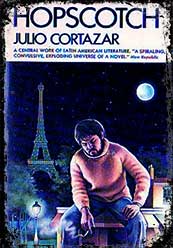
Synopsis: The novel revolves around Horacio Oliveira, an Argentine intellectual living in Paris with his bohemian friends (“The Serpent Club”) and his lover, La Maga. The story deals with his existential anxieties, romantic failures, and intellectual pursuits. The narrative switches between Paris and Buenos Aires, encompassing conversations, observations, and internal monologues that range from the mundane to the philosophically complex.
Themes: Like many works of its time, this classic Spanish novel explores existential questions related to identity, meaning, and the absurdity of life. Oliveira’s philosophical inquiries and inability to maintain a stable sense of self serve as a central focus. Cortázar is deeply interested in the mechanics of storytelling. By offering multiple ways to read the novel—linearly or by “hopscotching” between chapters—the book becomes a critique of linear narrative forms and turns reading into an interactive experience.
Analysis: The novel explores themes related to metaphysics and reality, referencing works of philosophy, psychology, and art to examine the complexities of human perception and the diversity of realities. It subtly comments on its time’s political and social milieu, particularly the intellectual scene in Argentina and the broader context of post-World War II Europe. The novel’s various love affairs, friendships, and social circles are a backdrop for its more abstract themes, focusing on the complexities and contradictions inherent in human relationships.
The rich and intricate language incorporates colloquial dialogue, philosophical monologues, and experimental prose. The novel is known for its challenging vocabulary, extensive footnotes, and multiple narrative voices. Its influence extends beyond literature into fields like philosophy, psychology, and even computer science, where it has been cited as an early example of “hypertext,” a text composed of multiple interconnected sections that can be read in various sequences.
8. In Search of Klingsor by Jorge Volpi (1999)
In Search of Klingsor (“En busca de Klingsor” in Spanish) is a novel by Mexican author Jorge Volpi. The book is part detective story, historical novel, and scientific inquiry. It covers the complexities of World War II and its aftermath, particularly focusing on the scientific community in Germany, including the involvement of scientists in Nazi projects. The book won numerous awards and established Jorge Volpi as a significant figure in contemporary Mexican and Latin American literature.
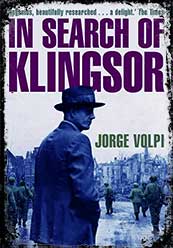
Synopsis: The story is set in the aftermath of World War II and follows two main characters: Francis Bacon, an American physicist, and Gustav Links, a mathematician. They are tasked with uncovering the identity of Klingsor, Hitler’s elusive scientific advisor responsible for the Nazi regime’s advances in science, particularly atomic research. The search leads them into the labyrinthine world of scientific discovery, ethical dilemmas, and human frailty.
Themes: One of the novel’s most significant themes is scientists’ ethical responsibility. The story provides a detailed look into how brilliant minds can be exploited for nefarious purposes, questioning the morality of scientific neutrality.
Analysis: The book confronts the catastrophic effects of war, not just in terms of human loss but also in the corruption and compromise of intellectual and moral values. As a suspenseful hunt for an enigmatic figure, the novel deals with themes of identity, both mistaken and concealed. The characters’ quest for Klingsor is a metaphor for deeper inquiries into the nature of human identity.
Through its multi-faceted characters, the book explores the complexities of human motivations, ethical decisions, and the unpredictable outcomes of those decisions. The novel mixes various narrative techniques, including third-person narration, interviews, and scientific discussions. The structure is intricate, weaving together multiple timelines and perspectives to create a complex tapestry that reflects the complications of the historical period it examines.
Moreover, it’s one of the books that launched the Crack movement, a literary movement in Mexico aimed at breaking away from the predominant narrative styles in Latin American literature. If you’re intrigued by the intersections of history, science, and ethics, this novel offers a deeply satisfying and intellectually stimulating experience.
9. The Shadow of the Wind by Carlos Ruiz Zafón (2001)
The Shadow of the Wind (“La Sombra del Viento” in Spanish) is a novel by Spanish author Carlos Ruiz Zafón. It has since become an international bestseller, translated into multiple languages, and celebrated for its intricate plot, well-developed characters, and atmospheric setting. The novel is the first in Zafón’s “Cemetery of Forgotten Books” series.
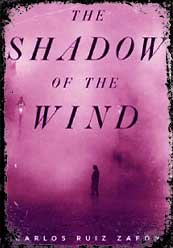
Synopsis: The story is set in post-Civil War Barcelona and follows a young boy named Daniel Sempere. When he is ten years old, his father takes him to the Cemetery of Forgotten Books, a hidden library where he selects “The Shadow of the Wind” by Julián Carax. As he grows up, Daniel becomes increasingly intrigued by the mysterious author and decides to learn more about him. His quest unravels a tapestry of secrets, betrayals, and tragedies intertwined with the history of Spain and its people.
Themes: The Cemetery of Forgotten Books is not just a physical place but a metaphor for the fragility of human memory and the importance of storytelling. The novel explores how stories and memories are preserved, altered, or forgotten over time through its labyrinthine plot.
Analysis: Various kinds of love are depicted—romantic, familial, and platonic. Forms of obsession complicate each, whether Daniel’s fascination with Carax or the various romantic entanglements that bind the characters.
Though not a political novel per se, it cannot escape the shadow of the Spanish Civil War and the subsequent dictatorship, which loom large over the characters’ lives, shaping their fates in profound ways. The book is structured as a literary thriller, with elements of mystery that keep the reader engaged. The quest to unravel Julián Carax’s enigma is the narrative’s main driving force.
The book-about-a-book motif allows Zafón to focus on the nature of storytelling, examining how narratives are created, interpreted, and passed down through generations. It’s linear but filled with flashbacks and stories-within-stories, each contributing a piece to the larger puzzle.
This was a commercial and critical success, garnering numerous awards and helping to rejuvenate interest in Spanish literature internationally. Its historical drama, romance, and mystery have made it popular among many readers, while its thematic depth has earned it critical acclaim.
10. The Celestina (La Celestina) by Fernando de Rojas
Celestina is a tragicomedy Spanish book written at the close of the 15th century. It’s an essential work in the pantheon of Spanish literature, considered a bridge between the medieval and Renaissance periods.
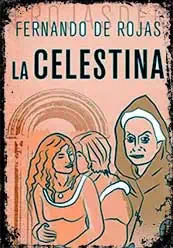
Summary: The story revolves around the passionate love of Calisto and Melibea, two young people from noble families in the city of Salamanca. When Calisto sees Melibea in her garden, he falls deeply in love with her. However, his attempts to woo her initially fail. Desperate to win her affections, he seeks the help of a go-between named Celestina.
Celestina is an old bawd and witch who has extensive knowledge about the secrets of love. With her machinations, including magic, manipulation, and deceit, she manages to arrange secret meetings between Calisto and Melibea. In the process, Celestina also becomes involved with Calisto’s servants, leading to a series of tragic events.
Themes and Significance: Calisto’s all-consuming love for Melibea is one of the central themes. Their relationship raises questions about the nature of love, its boundaries, and its consequences. Celestina’s character represents the corrupting influence of greed. Her manipulations lead to tragic outcomes for several characters. Through the tragic outcomes and the character flaws displayed, the work critiques the moral decay of society.
So, it’s a groundbreaking piece in Spanish literature, transitioning from the medieval to the modern and setting the stage for later literary masterpieces.
Classic Spanish books for beginners
Suppose you’re a Spanish language beginner or looking for easier reads in Spanish literature. In that case, it’s best to start with works that are either for learners or are inherently simple in language and structure. Here’s a list of Spanish books that are suitable for beginners:
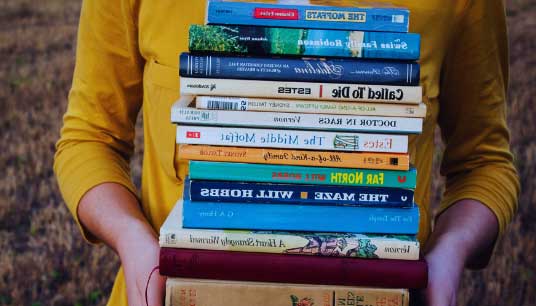
First Spanish Reader – A Beginner’s Dual-Language Book by Angel Flores: This book contains short stories from classic authors in Spanish and English.
Papelucho series by Marcela Paz: These children’s books from Chile offer a delightful and straightforward introduction to everyday Spanish.
Manolito Gafotas by Elvira Lindo: A fun series about the adventures of a young boy in Madrid. The language is contemporary and not too complex.
Cuentos de Eva Luna (Stories of Eva Luna) by Isabel Allende: A collection of stories easier to digest than a long novel yet offers a taste of Allende’s magical realism.
Cuentos de la selva (Jungle Tales) by Horacio Quiroga is a collection of short stories covering animals and the jungle, written in a clear and accessible style.
Spanish Graded Readers: These are books written specifically for Spanish learners. They include glossaries and comprehension questions and are graded by difficulty. Popular series include “Easy Spanish Step-by-Step” by Barbara Bregstein and the “Read It! Readers en Español” series.
El Principito (The Little Prince) by Antoine de Saint-Exupéry: The Spanish translation of this universally loved classic is an excellent choice for beginners.
Mi primer libro de poesía (My First Book of Poetry): A collection of Spanish poems suitable for children or beginners, introducing them to the rhythm and beauty of Spanish in small, digestible chunks.
“¡Te quiero, Valeria!” by Elisenda Roca: A delightful story that can be used by those just starting with Spanish reading.
The key is to find a balance between comprehensibility and challenge. As you read, don’t get discouraged if you don’t understand every word. The context and your existing knowledge can help you decipher the meaning, and your comprehension will improve with consistent practice.
Classic Spanish books for intermediate
If you’re at an intermediate level in Spanish, you’re probably ready to delve into slightly more challenging material. Here’s a list of classic Spanish books that are suitable for intermediate learners:

La tía Tula by Miguel de Unamuno: This novel, set in the early 20th century, discusses themes of love, sacrifice, and societal roles.
Nada by Carmen Laforet: A coming-of-age novel that focuses on post-Civil War Spain through the eyes of a young woman in Barcelona.
El camino by Miguel Delibes: The story of a young boy named Daniel and his experiences growing up in a small Spanish village.
Los santos inocentes by Miguel Delibes: A portrayal of the extreme poverty and class differences in rural Spain during Franco.
Don Juan Tenorio by José Zorrilla: This is a classic Spanish play that recounts the legendary story of the famous seducer, Don Juan.
Historia de una escalera by Antonio Buero Vallejo: A significant 20th-century play that spans three generations, discussing dreams, social mobility, and human connection.
Marina by Carlos Ruiz Zafón: Before his worldwide hit “La sombra del viento,” Zafón wrote this engaging young adult novel set in Barcelona.
Relato de un náufrago (The Story of a Shipwrecked Sailor) by Gabriel García Márquez: Based on a true story, this novel recounts the ordeal of a sailor stranded at sea.
La casa de los espíritus (The House of the Spirits) by Isabel Allende: An introduction to magical realism and the intricate history of a Chilean family across generations.
How to read classic Spanish books?
When reading, consider the following tips:

Use a Spanish dictionary: If you encounter words or phrases you’re unfamiliar with, use a dictionary. Over time, you’ll expand your vocabulary and enhance your understanding of the text.
Summarize what you read: After each chapter or section, take a moment to summarize what you’ve read in your own words. This practice reinforces comprehension.
Join a book club: Consider joining or starting a Spanish book club. Discussing the books you read with others can provide valuable insights and make the learning process more enjoyable.
Remember to enjoy the process. Reading these classics improves your language skills and deepens your appreciation of Hispanic culture and literature.
Famous Spanish literature authors
Spanish literature boasts a rich tradition and has produced some of the world’s most renowned authors, poets, and playwrights. Here’s a list of some famous Spanish literature authors spanning from the Middle Ages to the contemporary era:
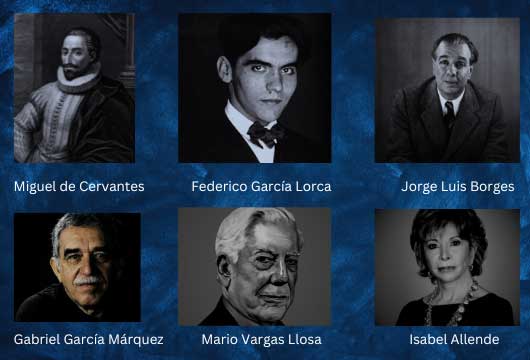
Miguel de Cervantes: He was the greatest writer in the Spanish language and authored “Don Quixote,” a foundational work of Western literature.
Federico García Lorca: A prominent member of the Generation of ’27, Lorca is famous for his plays like “Blood Wedding” and poetry collections like “Gypsy Ballads.”
Jorge Luis Borges: An Argentine writer famous for his intricate and philosophical short stories, Borges’ works include “Ficciones” and “Labyrinths.”
Gabriel García Márquez: The Colombian author who won the Nobel Prize in Literature in 1982 is best popular for “One Hundred Years of Solitude,” a landmark in the magical realism genre.
Mario Vargas Llosa: A Peruvian writer who received the Nobel Prize in Literature in 2010, he penned novels such as “The Time of the Hero” and “The Feast of the Goat.”
Isabel Allende: A Chilean-American novelist, she’s famous for mixing magical realism with historical fiction in works like “The House of the Spirits.”
Pablo Neruda: A Chilean poet-diplomat and politician, Neruda won the Nobel Prize in Literature in 1971. His “Twenty Love Poems and a Song of Despair” is one of the most celebrated poetry collections in the Spanish language.
Julio Cortázar: An Argentine novelist and short story writer, he’s popular for experimental works such as “Hopscotch” and “Blow-up and Other Stories.”
Benito Pérez Galdós: One of Spain’s most significant novelists, his works, including the “Episodios Nacionales” series, provide a panoramic view of Spanish society in the 19th century.
Pedro Calderón de la Barca: A key figure in Spanish Golden Age theatre, he wrote the famous play “Life Is a Dream.”
Lope de Vega: Another giant of the Spanish Golden Age, he penned numerous plays and is compared to Shakespeare in terms of his prolific output and influence.
Juan Ramón Jiménez: A Spanish poet who won the Nobel Prize in Literature in 1956, he’s best known for “Platero y Yo.”
Rosario Castellanos: A Mexican poet, novelist, and essayist, she highlighted the roles of women and indigenous peoples in her works.
This list provides only a snapshot of Spanish literature’s immense talent and diversity. Each author has contributed uniquely to the literary landscape, and their works continue to inspire readers worldwide.
Last Words
From the gripping narratives of adventure and intrigue to profound explorations of human nature and society, these works are not just books; they are gateways to understanding the heart and soul of Spanish culture and history. I hope this journey has sparked your curiosity and inspired you to delve deeper into these timeless classics.
Literature is a bridge connecting past and present. Through these classic Spanish books, we can travel across time and immerse ourselves in the stories that have shaped not only Spanish literature but also the world’s literary heritage. Thank you for joining me on this exploration. Until next time, happy reading!
Read More:
American Literature Books Like East Of Eden
Japanese Literature Books Like No Longer Human
10 Traditional Literature Books
Classic Authors Like Jane Austen
Table of Contents
